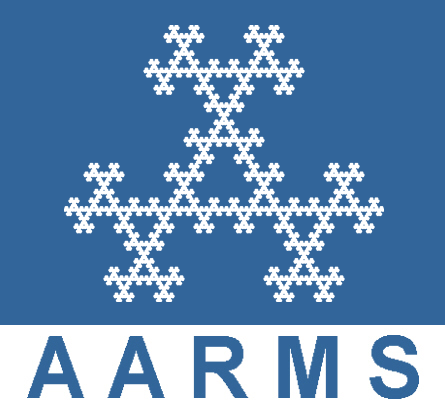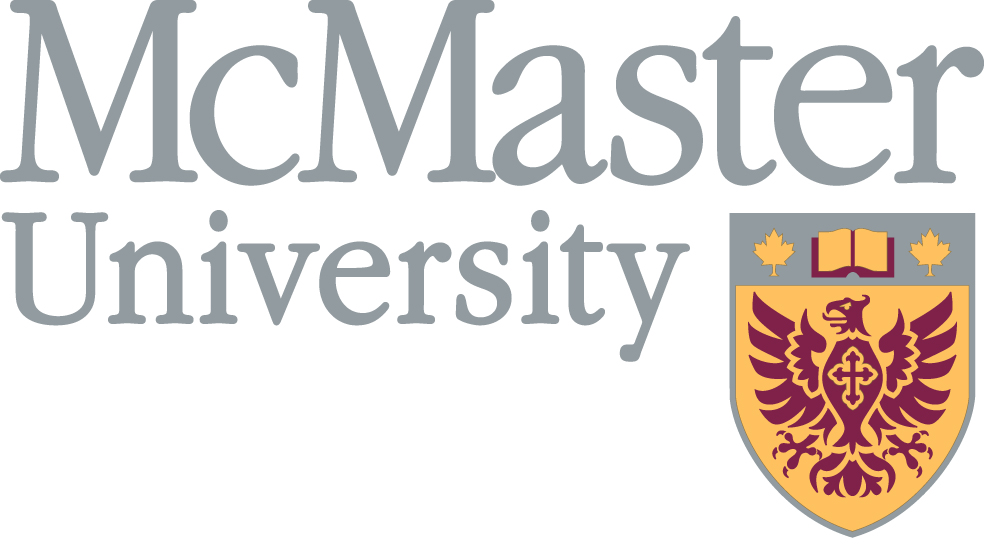Réunion d'hiver SMC 2016
Niagara Falls, 2 - 5 décembre 2016
Org: Sara Faridi (Dalhousie University), Federico Galleto (McMaster University) et Adam Van Tuyl (McMaster University)
[PDF]
- ALI ALILOOEE, University of Wisconsin-Stout
REGULARITY OF POWERS OF UNICYCLIC GRAPHS [PDF]
-
Castelnuovo–Mumford regularity is one of the most important invariants in commutative algebra. It has been investigated by various authors from different point of view. One of the interesting properties of regularity is its asymptotic behavior. In this talk first we will see some well-known facts of regularity and then I will present some known results of asymptotic behavior of quadratic squarefree monomial ideals (edge ideal of a graph). At the end my recent work with Selvi Beyarslan about regularity of unicyclic graphs will be presented.
- JENNIFER BIERMANN, Hobart and William Smith Colleges
Bounds on the regularity of toric ideals of graphs [PDF]
-
Let $G$ be a finite simple graph. We give a lower bound for the Castelnuovo-Mumford regularity of the toric
ideal $I_G$ associated to $G$ in terms of the sizes and number of induced complete bipartite graphs in $G$. When $G$ is a chordal bipartite graph, we find an upper bound for the regularity of $I_G$ in terms of the size of the bipartition of $G$.
- RAGNAR-OLAF BUCHWEITZ, University of Toronto Scarborough (UTSC)
Constructing all graded torsionfree modules over quasi-homogeneous Gorenstein curve singularities [PDF]
-
In this joint work with Iyama and Yamaura we show that the stable category
of graded maximal Cohen-Macaulay modules over a quasi-homogeneous
Gorenstein curve singularity with nonnegative a-invariant admits an
(explicit!) tilting object.
This means, in particular, that that triangulated category is exact equivalent to the derived category of modules of finite length over a (usually noncommutative) Artin algebra. If the singularity is reduced, then that Artin algebra is of finite global dimension and one can use this to construct any graded torsionfree module over the curve singularity through finitely many extensions of finitely many modules and their (co-)syzygies.
- KAI FONG ERNEST CHONG, Nanyang Technological University
Beyond the g-theorem [PDF]
-
The $g$-theorem is a momentous result in combinatorial commutative algebra that characterizes the $f$-vector of a simplicial polytope $\Delta$. In all its known proofs, a suitable graded algebra $R$ is considered, whose Hilbert function encodes the $h$-vector of $\Delta$, and the difficult part is to show that $R$ admits a Lefschetz decomposition. More recently, there has been much interest in the $g$-conjecture, which asserts that the $g$-theorem can be extended to all simplicial homology spheres. In this talk, we introduce the ``stress algebra'', an Artinian Gorenstein graded algebra with geometric significance that can be associated to any simplicial homology sphere, and we explain its relevance to the $g$-conjecture. This is joint work with Tiong Seng Tay.
- NURSEL EREY, North Dakota State University
Powers of Edge Ideals with Linear Quotients or Linear Resolutions [PDF]
-
A classical result of Fr\"{o}berg states that the edge ideal $I(G)$ of a graph $G$ has linear minimal free resolution if and only if the complement graph $G^c$ is chordal. For edge ideals, Herzog, Hibi and Zheng showed that having linear minimal free resolutions is also equivalent to having linear quotients. Moreover, they proved that if $I(G)$ has a linear minimal free resolution, then every power of $I(G)$ has linear minimal free resolution. This result was extended by D'Al\`i by showing that every power of $I(G)$ has linear quotients if $I(G)$ has linear quotients.
I will provide linear quotients orderings for powers of edge ideals of some graphs and present related results. In the second part of my talk, I will talk about the problem of describing edge ideals whose powers eventually have linear resolutions. In particular, I will discuss powers of edge ideals of some gap-free graphs.
- SVENJA HUNTEMANN, Dalhousie University
Simplicial Complexes of Strong Placement Games [PDF]
-
Strong Placement Games are a class of 2-player, perfect information games in which pieces are placed on a graph (the board), and the order of the placement does not matter. To each strong placement game we can assign two simplicial complexes, the legal and illegal complex, which have a natural bipartition of vertices corresponding to each player. We will show that in turn every simplicial complex with a specified bipartition is the legal and illegal complex of some strong placement games. The case in which the legal complex is a flag complex is further studied. This is joint work with Sara Faridi and Richard Nowakowski.
- NATHAN ILTEN, Simon Fraser University
Stanley-Reisner degenerations for dual quotient bundles on G(2,n) [PDF]
-
Let $\mathcal{Q}^*$ denote the dual of the quotient bundle on the Grassmannian $G(2,n)$. I will discuss how the ideal of $\mathcal{Q}^*$ in its natural embedding has initial ideal equal to the Stanley-Reisner ideal of a certain unobstructed simplicial complex. This can be viewed as a generalization of Sturmfels' classical result relating the Plücker ideal of $G(2,n)$ to the $n$-associahedron. As corollaries, we obtain that the coordinate ring of $\mathcal{Q}^*$ is Cohen-Macaulay and, for $n>5$, has no infinitesimal deformations. This is joint work with Charles Turo.
- MARYAM EHYA JAHROMI, Dalhousie University
Whitney's Theorem and Subideals of Monomial Ideals [PDF]
-
The reconstruction of a graph from certain subgraphs has always
been an interesting topic in graph theory and is still an open question. The vertex-deck (or simply the deck) of a graph $G$ is the family of all its subgraphs which are
obtained by removing exactly one vertex of $G$. Similarly we
can define the edge-deck of a graph $G$.
The main question is whether one can uniquely determine a graph from its unlabeled vertex-deck. In 1964, Harary conjectured that any two graphs with at least four edges and the same edge-deck are isomorphic.
Long before that, in 1932 Whitney proved that if the line graphs of two simple graphs $G$ and $H$ are isomorphic, then $G$ and $H$ are also isomorphic except for the cases $K_3$ and $K_{1,3}$. Using this result, Hemminger proved that the edge reconstruction conjecture for graphs is equivalent to the vertex reconstruction conjecture for line graphs.
Trying to extend Whitney's theorem to hypergraphs, Berge introduced two hypergraphs $\mathcal{E}_p$ and $\mathcal{O}_p$ and proved that if two hypergraphs have isomorphic $(p-1)$-edge-decks then they are isomorphic only if they do not contain an $\mathcal{E}_p - \mathcal{O}_p$ pair. In 1987 Gardner proved the other direction under extra hypotheses.
In this talk we will discuss the ideal theory of hypergraphs with isomorphic $(p-1)$-edge-decks, using the results mentioned above.
- JACK JEFFERIES, The University of Michigan
Local Okounkov Bodies and Limits in Positive Characteristic [PDF]
-
This is based on joint work with Daniel Hernández.
The Hilbert-Samuel multiplicity of an m-primary ideal is a well-known example of an interesting numerical invariant in Commutative Algebra. For rings of positive characteristic, there are many invariants that are analogous to the Hilbert-Samuel multiplicity, but instead are defined via sequences of ideals related by the Frobenius map. In general, such sequences exhibit non-polynomial growth, and existence of limits is a difficult question.
In this talk, we will discuss a proof of the existence of many limits in this context. Our method realizes these positive characteristic multiplicities as volumes of regions in euclidean space. In addition to existence, this association provides new insights into these numerical limits.
- HASAN MAHMOOD, Department of Mathematics, GC University Lahore, Pakistan.
A NOTE ON F- IDEALS [PDF]
-
$f$-vector is an important invariant of a simplicial complex $\Delta$. It is also very useful in computing the Hilbert series of the Stanely-Reisner ring $K[\Delta]$. $f$-Ideals are precisely those square-free monomial ideals in the polynomial ring $S=K[x_1,x_2,\ldots, x_n]$ for which the corresponding facet complex and the non-face complex have the same $f$-vector. Thus, for an $f$-ideal $I$, the Hilbert series of $S/I$ can be computed more easily, by using the $f$-vector of facet complex of $I$. The notion of $f$-ideals is recent, and have so far been studied in the papers given in references only. In my talk, I will present, systematically, what have been done in this particular direction, and propose some new problems to see what can be done more.
\begin{thebibliography}{9}
\bibitem {deg2} Abbasi, G.Q., Ahmad, S., Anwar, I. and Baig, W.A., 2012. f-Ideals of degree 2. Algebra Colloquium Vol. 19, No. spec01, pp. 921-926.
\bibitem{degd} Anwar, I., Mahmood, H., Binyamin, M.A. and Zafar, M.K., 2014. On the characterization of f-Ideals. Communications in Algebra, 42(9), pp.3736-3741.
\bibitem{tswu1} Guo, J., Wu, T. and Liu, Q., 2013. Perfect sets and $ f $-Ideals. arXiv preprint arXiv:1312.0324.
\bibitem{tswu2} Guo, J., Wu, T.,2015. On the $(n,d)^{th}$ $f$-ideals, J. Korean Math. Soc. 52(4), pp.685-697.
\bibitem{fgraph} Mahmood, H., Anwar, I. and Zafar, M.K., 2014. A construction of Cohen-Macaulay f-graphs. Journal of Algebra and Its Applications, 13(06), p.1450012.
\bibitem{fsimp} Mahmood, H., Anwar, I., Binyamin, M.A. and Yasmeen, S., 2016. On the connectedness of f-simplicial complexes. Journal of Algebra and Its Applications, p.1750017.
\end{thebibliography}
- SARAH MAYES-TANG, Quest University Canada
Betti tables of graded systems of ideals [PDF]
-
Several patterns emerge in collections of Betti tables associated to the powers of a fixed ideal. For example, Wheildon and others demonstrated that the shape of the nonzero entries in these tables eventually stabilizes the fixed ideal has generators of the same degree. In this talk we will discuss patterns in the graded Betti numbers of other graded systems of ideals. In particular, we will describe ways in which the Betti tables may stabilize, and how different types of stabilization are reflected in the corresponding Boij-S\"{o}derberg decompositions.
- JONATHAN MONTANO, University of Kansas
The Core of Monomial Ideals [PDF]
-
Let $R$ be a commutative ring and $I$ an $R$-ideal. Rees and Sally defined the core of $I$ as the intersection of all of its reductions. In general it is very hard to explicitly compute the core of an ideal as it may require the intersection of infinitely many ideals. In this project we find a formula for the core of monomial ideals satisfying certain residual assumptions. This is work in progress jointly with Louiza Fouli, Claudia Polini, and Bernd Ulrich.
- REBECCA R.G., Syracuse University
Directed families of big Cohen-Macaulay algebras in equal characteristic [PDF]
-
A big Cohen-Macaulay algebra over a local ring $R$ is an algebra $B$ such that every system of parameters on $R$ is a regular sequence on $B$. Previously, Geoffrey Dietz proved that big Cohen-Macaulay algebras in characteristic $p>0$ form a directed family. In joint work with Geoffrey Dietz, we extend these results to the equal characteristic $0$ case using work of Schoutens on reduction to characteristic p via ultraproducts. This work has applications to the use of closure operations to study singularities.
- ALESSIO SAMMARTANO, Purdue University
Blowup algebras of rational normal scrolls [PDF]
-
The Rees ring and the special fiber ring of a polynomial ideal $I$, also known as the blowup algebras of $I$, play an important role in commutative algebra and algebraic geometry. A central problem is to describe the defining equations of these algebras. I will discuss the solution of this problem when $I$ is the homogeneous ideal of a rational normal scroll.
- DAVID WEHLAU, Royal Military College and Queen's University
Homogeneous regular sequences and symmetric group actions [PDF]
-
Consider a polynomial ring $R$ on $n$ indeterminants equipped with the action of a group $G$ acting via algebra automorphisms. A set of $n$ homogeneous polynomials $\{f_1,f_2,\dots,f_n\} \subset R $ forms a {\it regular sequence} if the origin is the only common zero of the $f_i$. Of particular interest are regular sequences for which the ideal $(f_1,f_2,\dots,f_n)$ they generate is stable under the action of $G$. A number of authors have considered the possible degrees $d_1,d_2,\dots,d_n$ of such sequences for various group actions. Concentrating on the natural action of the permutation group on $n$ letters, I will describe some of the known results and open questions about possible values for the $d_i$.
This is joint work with Federico Galetto (McMaster) and Tony Geramita (Queen's).





